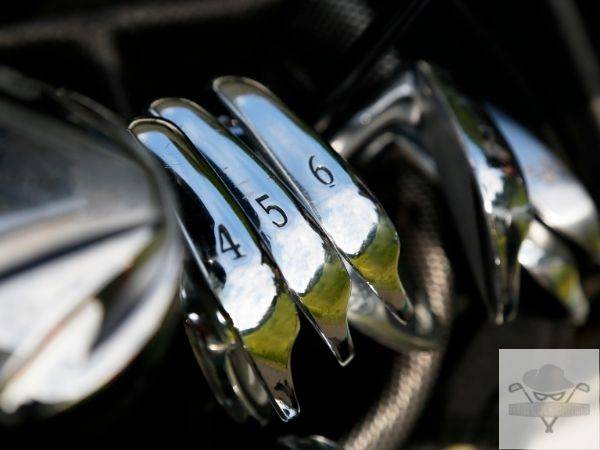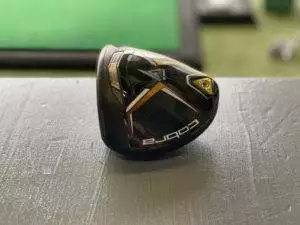If you are new to golf, you might wonder, what is a 6-iron golf club?
Irons are generally used for a variety of shots from different distances, and each iron is designed for a specific range.
These clubs have more loft than most fairway woods, which means they launch at a higher trajectory and usually travel shorter distances.
A 6 iron is considered a mid-iron and primarily used for full shots from a variety of lies.
Keep reading to learn more about the average 6-iron loft, lie angle, potentially replacing it with a hybrid, and a few tips to hit it consistently well.
6 Iron Golf Club – What You Need to Know
A 6 iron is typically used for medium to long shots, anywhere from 150 yards to 180 yards for most golfers.
It’s a pretty versatile club that is used from fairways, rough, or even fairway bunkers (assuming there isn’t a big lip to carry).
Let’s start by understanding the dimensions of this club.
6 Iron Length
So, what is the length of a 6-iron golf club?
The standard length for a 6 iron is 37.5 inches for men and 36.5 inches for women. However, some golfers may have clubs that are an inch or two shorter or longer based on height.
Shorter golfers need a slightly shorter shaft, while taller players need a longer shaft to match their height.
If you’re not sure if your 6-iron (or any club) is right for your size, you could get your clubs fitted.
This is where a professional will measure your height, arm length, and help you choose the right length for your clubs.
Average 6 Iron Loft and Lie Angle
The loft is between 24 and 31 degrees, depending on the make and model of your irons.
Game improvement or super game improvement (the most forgiving type of irons) tend to have stronger lofts (24-26 degrees). This makes it easier to hit them longer distances, even with slower swing speeds.
Muscleback and blade irons are used by better golfers and have more loft (27-31 degrees). This helps players launch them higher, land softer, and allow them to work the golf ball more as well.
You can always change the loft of your irons by a degree or two to strengthen or weaken the lofts. This will help change the distances and blend certain clubs with others in your set.
For example, you might bend a 5-iron to a different loft so it doesn’t create a big distance gap with a hybrid.
Average 6 Iron Distance
A 6-iron is a mid-range club that typically travels between 150–180 yards, depending on clubhead speed and mechanics, for male golfers.
Female golfers tend to hit them 20–30 yards shorter, but clubhead speed is the biggest factor for distance. The shaft also plays a big role in how far you can hit a 6-iron.
For instance, graphite shafts are lighter, easier to swing faster, and can add yards to your total distance. While steel shafts can help improve accuracy when hitting into greens. Choosing the right set of irons is key, but so is the shaft that’s in them as well.
Professional golfers and skilled amateurs might hit this club a lot further, too. It’s not uncommon to see skilled players hit a 6-iron 170-200+ yards depending on ball speed, wind, temperature, and elevation.
Perhaps the most famous 6-iron ever hit was by Tiger Woods in the 2000 RBC Canadian Open. On the 18th hole, he did the impossible… hitting a 6-iron 218 yards from a wet fairway bunker… over water!
The shot launched into the stratosphere, over the lake, and landed on the back of the green. He went on to make birdie and win yet another PGA Tour event. Scott Verplank said it was the greatest shot he’s ever seen in his life.
Here’s the YouTube video if you haven’t had a chance to see one of the most iconic shots from the GOAT.
When Should You Use a 6-Iron Golf Club?
A 6-iron golf club is primarily used for full swing shots on par 3s, from the fairway, out of the rough, and sometimes fairway bunkers… if you’re like Tiger. The club doesn’t have a ton of loft, so it’s not as easy to hit as a 7 or 8-iron.
Here are some of the most common scenarios to hit a 6-iron:
- Mid-length par 3s.
- Punch shots under trees.
- Fairway bunkers with minimal lip.
- Knockdown shots when hitting into the wind.
- Sitting up in the rough with a good lie. Avoid this club in thick rough, as the hosel can get twisted in thick grass and lead to some big misses.
Unlike other irons and wedges, a 6-iron is not used for short game shots around the green.
Since it has such little loft, it’s nearly impossible to get any spin, as the ball will hit and roll out.
What Are Some Pros and Cons of Using a 6 Iron?
Like every golf club in the set, there are pros and cons.
Pros
- Mid-trajectory.
- Easier to hit than long irons.
- Good option to lay up short of hazards.
- Can hit from the fairway, rough, bunkers, or off a tee relatively easily.
- A good club to use in practice when learning the fundamentals of the golf swing. It’s also one of the most commonly used clubs if you do a professional fitting as well.
Cons
- Less forgiving than hybrids.
- A little bit harder to hit than 7 iron.
- Can be more difficult to control than shorter clubs.
How to Hit a 6 Iron Golf Club
To hit your golf goals and become a more consistent ball striker, you’ll need to dial in the fundamentals to strike a 6-iron well. Here are the biggest things to think about when hitting this mid-iron.
Ball Position
One of the most important things to note when hitting a 6-iron (or any club) is ball position. You want the ball slightly ahead of center (about an inch).
One of the most common mistakes that most golfers make is moving it too far up in their stance. This leads to hitting up on the ball and thinning it, vs. finding the sweet spot with a downward strike.
A 6 iron is one of the clubs you hit down on with ball first contact. To achieve this, make sure that you take a divot after the ball. If you don’t, it means that you are either hitting up on the ball or you are topping it.
On the driving range, test out different ball positions (slightly forward of center and center) to see how it impacts ball flight and shot shape.
Weight Distribution and Stance
To hit a 6 iron, take your stance with your feet shoulder-width apart, with each foot slightly flared externally so you can make a full turn. It’s a good idea to have a little more weight on your lead foot for a proper weight transfer, too.
Next, make sure to control your tempo and don’t try to hit the ball too hard, like so many golfers do with long irons. The club will do the work for you.
A good way to control your tempo is to count “one-one thousand, two-one thousand” as you swing. This will help you keep a consistent tempo and avoid overswinging.
Hips and shoulders should turn together and your weight should transfer from your back foot to your front foot. The club should be in a position where your arms are extended but not locked, and your wrists are cocked.
At impact, the clubface should be square to the target line and your weight should be transferred to your front foot. Follow through with your swing and finish in a balanced position.
If you want to hit more of a knockdown shot, try to finish lower – less than shoulder height. This will flight down the trajectory and typically straighten out your ball flight too.
Closing Thoughts
A 6-iron is a club that comes with part of your iron set and is considered a mid-iron. It’s easier to hit than longer irons, but not as easy to hit as shorter irons.
If you are looking to improve your game, the 6 iron is a great club to practice with, as it can be used in a variety of situations.
If you can’t hit your 6-iron consistently well, you might consider swapping it out for a high lofted fairway wood or hybrid instead.




